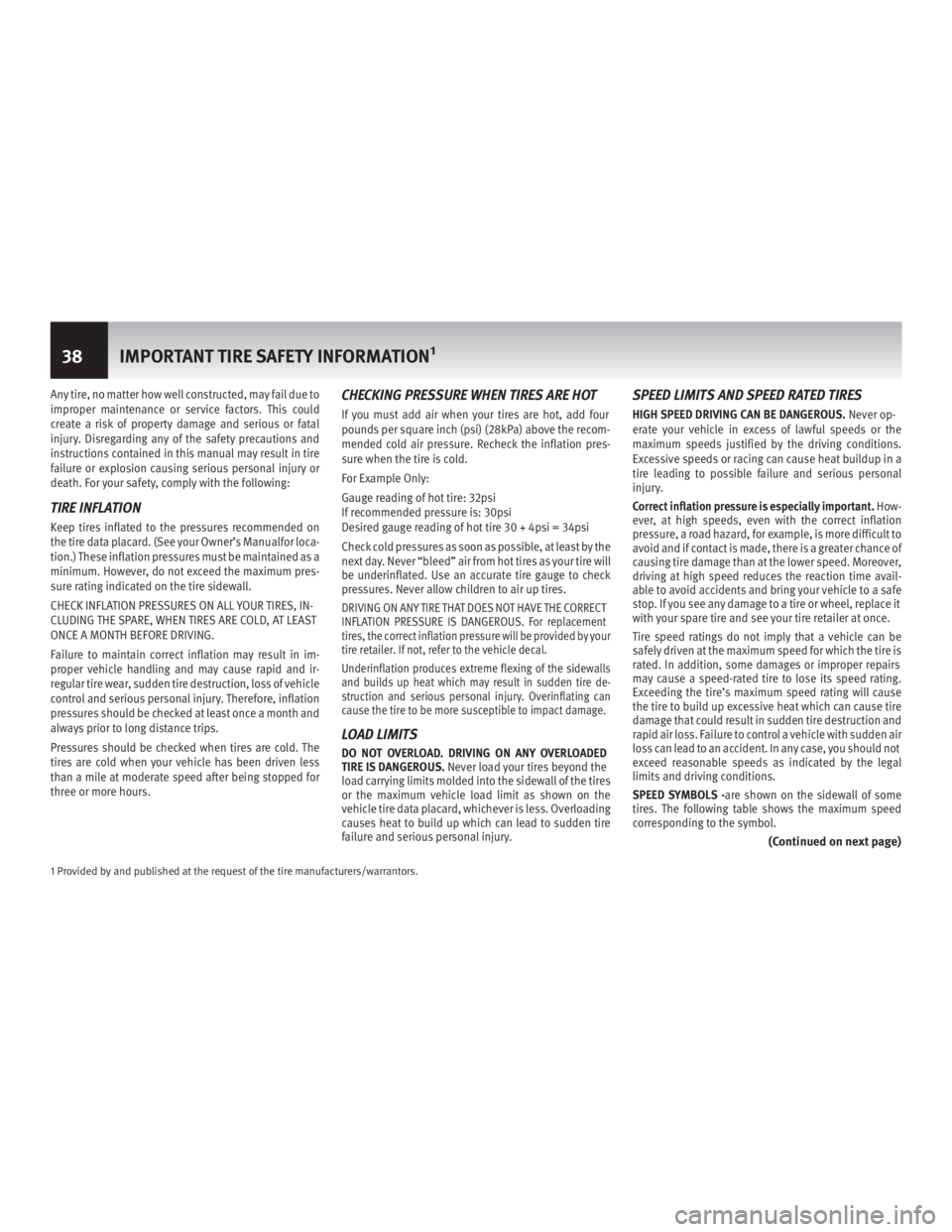stop start INFINITI QX80 2016 Warranty Information Booklet
[x] Cancel search | Manufacturer: INFINITI, Model Year: 2016, Model line: QX80, Model: INFINITI QX80 2016Pages: 52, PDF Size: 0.39 MB
Page 44 of 52

SPEED RATINGS
†Speed S peed
Maximum Rating mph km/Hr
M 81 130 N 87 140P 93 150
R 99 160
R 106 170
S 112 180 T 118 190
H 130 210
W 168 270 Y 186 300
V* 149 240
Z** 149 240
*Some V (or VR) rated tires may have a speed capacity
of greater than 149 mph (240 km/h). Consult your tire
manufacturer for maximum speed ratings if your vehicle
capability exceeds this speed.
**Z (or ZR) rated tires are designed for use on cars with
maximum speed capabilities in excess of 149 mph
(240 km/h). Consult your tire manufacturer for maxi-
mum speed capabilities.
†Although a tire may be speed rated, we do not endorse
the operation of any vehicle in an unsafe or unlawful
manner. Speed ratings are based on laboratory tests
which relate to performance on the road, but are not
applicable if tires are underinflated, overloaded, worn
out, damaged, altered, improperly repaired, or re-
treaded. Furthermore, tire speed ratings do not imply that vehicles can be safely driven at the maximum speed
for which the tire is rated, particularly under adverse
road and weather conditions or if the vehicle has un-
usual characteristics. Most highway passenger tires that
do not have a speed symbol in the sidewall have a
maximum speed rating of 105 mph. Light truck highway
tires that do not have a speed symbol on the sidewall of
the tire have a maximum speed of 87 mph. Some light
truck tires may have higher maximum speeds; consult
your tire retailer. The speed and other ratings of re-
treaded tires are assigned by the retreader and voids the
original manufacturer’s ratings.
IMPORTANT:
In order to maintain the speed capability
of the vehicle, replacement tires must have speed rat-
ings equal to or higher than those fitted as original
equipment (as indicated on the vehicle placard or Own-
er’s Manual). If tires with lower speed ratings are fitted,
the speed capability of the vehicle will be lowered to the
maximum speed capability of the replacement tire as
indicated on the above table.
Remember...High speed driving can be dangerous and
may be damaging to your tires.
And...When driving at highway speeds, correct inflation
pressure is especially important.
Contact the manufacturer of your tires for their position
and assistance on the repair of speed-rated tires. When
you are replacing tires that have a speed rating, you must
replace with tires of the same or higher speed rating if the
speed capability of the vehicle is to be maintained.
VISUAL INSPECTION
INSPECT YOUR TIRES. DO NOT DRIVE ON A DAMAGED
TIRE OR WHEEL. Check your tires frequently for scrapes, bulges, separations, cuts, snags, cracks, penetrations
or excessive localized wear from hard braking. Also
check for abnormal tire wear, particularly on the edges
of the tire tread which may be caused by misalignment
or underinflation. Impacts can damage the inner por-
tion of the tire without being
visible onthe outside. If
damage can be seen on the tires or wheels, or if you
suspect that possible impact damage may have oc-
curred, replace with spare at once and have your tire
store or retailer inspect your tires immediately. Use of a
damaged tire could result in tire destruction. When in-
specting your tires, including the spare, check your air
pressures. If your pressure check indicates that one of
your tires has lost pressure of two pounds or more, look
for signs of penetrations, valve leakage, or wheel dam-
age that may account for the air loss.
All tires will wear out faster when subjected to high
speeds as well as hard cornering, rapid starts, sudden
stops, frequent driving on roads which are in poor con-
dition, and off-road use. Roads with holes and rocks or
other objects can damage tires and cause misalignment
of your vehicle. When you drive on such roads, drive on
them carefully and slowly, and before driving again at
normal or highway speeds, examine your tires for any
damage, such as cuts, bulges, penetrations, unusual
wear patterns, etc.
TREAD WEAR INDICATORS (WEAR BARS): Tires contain
Tread Wear Indicators (Wear Bars) in the grooves of the
tire tread which show up when only 2/32nds of an inch
(1.6mm) of tread is remaining. At this stage, your tires
must be replaced. Tires worn beyond this stage are
dangerous.
(Continued on next page)
IMPORTANT TIRE SAFETY INFORMATION139